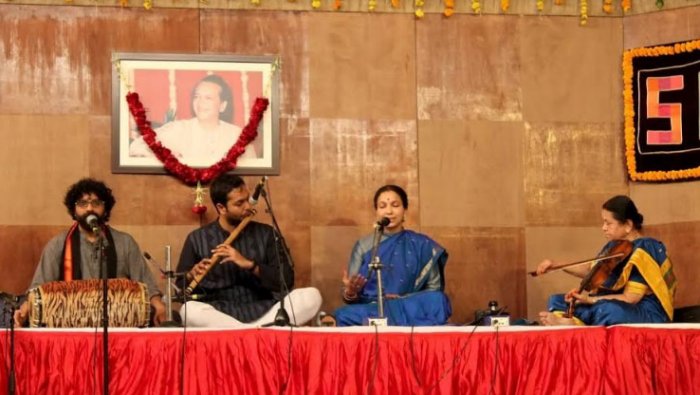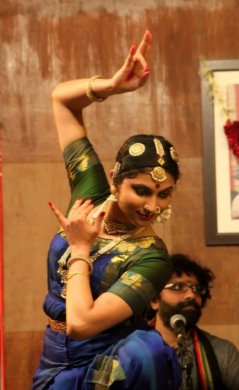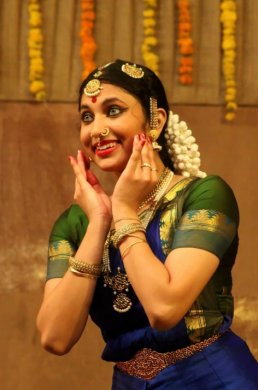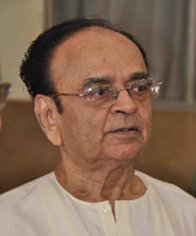
|   |

|   |
Jayanti Ravi's rich musical tribute to M.S. Subbulakshmi - Dr. S.D. Desai e-mail: sureshmrudula@gmail.com January 25, 2020 A child prodigy, M.S. Subbulakshmi (1916-2004) fully bloomed in her life and became a genius in music. This growth in the realm of music is proportionate to her becoming one of the best specimens of humankind. Music with its primordial rise with the origin of the earth is so aligned to life. Dr. Jayanti Ravi has the requisite qualities to pay a musical tribute to MS. She has acquired a pretty high level of musical skills and she seems to have had spiritual leanings through her genes. They are anchored by a rational approach to life in the modern times. Her tribute, An Ode to the Nightingale, Bharat Ratna M S Subbulakshmi at Saptak Music Festival in the first session of its penultimate day (January12) was very well received. She has a knack of combining Katha (narrative), music and dance in her presentation. The narrative, intermittently used while she renders hymns, is based on modest research and her rendering from time to time finds a brilliant visual expression in the simultaneous Bharatanatyam solo performance by her daughter Krupa Ravi Nityesh, who for many years now has been under the informed tutelage of Dr. Ananda Shankar Jayant (Hyderabad) following initial training at Dolly Desai's Bharatakalanjali in Ahmedabad. The flute is played by her son Adit, a student at Saptak. As for the credits, a special mention must be made of Satish Krishnamurthy on the mridangam.  The tone is set with the famous Daru Varnam Maate Malayadhvaja in raag Khamas solemnly invoking goddess Durga, the compassionate empress of Sakala Tribhuvana, in clearly enunciated words. Simultaneously, Krupa gives a visual interpretation of the goddess's traits and the divine grandeur of her being. It was the Queen of Music, Kunjamma, Kunju to her mother, who popularized the Varnam at a young age from Madurai, a city of temples and celebrated musicians. The feeling of oneness of the universe and of the being within each one of us gets intensified when the vocalist sweetly renders a Sanskrit stanza from Saundarya Lahari and the dancer depicts awakening of the Kundalini from Mooladhar to Sahasrar Chakra with alacrity suggesting their correspondence with the elements. Later, there is a delectable composite presentation of Madhurashtakam, which begins with an appreciation of the beatific visible image of the divine form and culminates in a feeling of pervading universal sweetness. The major vocal rendering was Bhavayami Raghuramam, originally Maharaja Swati Tirunal's glittering dainty gem of a composition in Sanskrit, in ragamalika beginning and ending with Saveri. The compact composition condensing the Ramayana was made popular by MS. The vocalist's singings of it demonstrates the devotion and joy it is rendered with. Incidentally, all the episodes of the epic get encapsulated in it with adjectives (formed with compound words) for Raghuputra Ram following the verb bhavayami (I contemplate on)! 

Performances by mother and daughter continued to remain engaging complementarily in form and communication. It is gladdening to see Krupa increasingly growing in her ease to express varying bhavas with rolling eyes and an expressive face pretty supplely moving across the stage with exhilaration. The 'MS blue' Kanchivaram sari the three women, including the violinist, wore assumed significance in the free movement of the young dancer. Satish's expert mridanga vadan, which at times gave a feel of being in a devotion-charged Madurai temple, was remarkable all through. Jayanti's intellectual embellishments to her aesthetic considerations do not go unnoticed. MS blue was one such idea. While giving a dash of Vishnusahasranamam she was quick to point out MS's husband Sadasivam's role in her life. At his suggestion she took two years to perfect doing it even after having it by heart. Down to earth simplicity and modesty coupled with dedication and devotion bestowed MS with personal charm. Giving details of her incredible performances as a child, her twin performances of acting and singing in the film Meera and association with stalwarts of her time, Jayanti turned towards the end to three of her significant vocal renditions, including Vishnusahasranamam, as the dancer turned to celebratory Tillana. There could not have been a more appropriate rendition at the UN General Assembly in 1966 than her immortal Maithreem Bhajata in a composition by Paramacharya of Kanchi. It makes an earnest appeal to the world to renounce ways of war and to have compassion for all on Janani Prithvi. Another gem in her inimitable voice, whose beauty has not diminished over time, was the Meera bhajan Hari tum haro jan ki peer. On Mahatma Gandhi's request, she specially recorded it for his 78th birthday and from Madras it was airlifted to Delhi. It was a tragic irony that four months later, All India Radio had to announce his death and air the bhajan. MS fainted after this and she is said to have never sung it again.  Dr. S.D. Desai, a professor of English, has been a Performing Arts Critic for many years. Among the dance journals he has contributed to are Narthaki, Sruti, Nartanam and Attendance. His books have been published by Gujarat Sahitya Academy, Oxford University Press and Rupa. After 30 years with a national English daily, he is now a freelance art writer. |